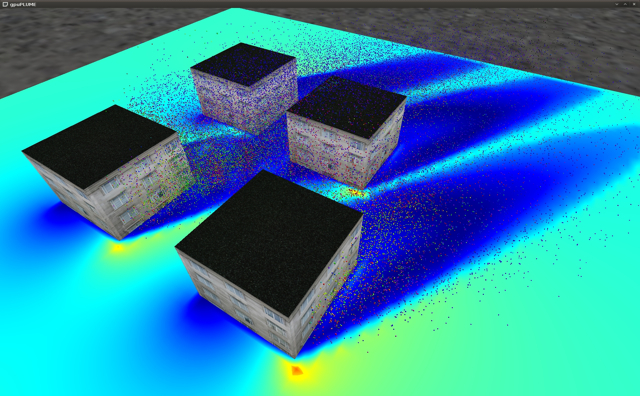Human populations are increasingly concentrated in urban regions, which, in turn, are becoming major centers of pollution and energy use. Our research aims to give urban planners tools to evaluate the impact of building location and form on pollution dispersal and energy needs.

Our research utilizes GPUs to accelerate dispersion simulation and heat energy transfer to solve problems related to minimizing pollution and energy usage in urban environments.
While prior research enabled single simulations that could predict the impact of a particular design on pollution concentrations, by harnessing the multi-core power of computer graphics hardware (i.e. Graphics Processing Units or GPUs) to quickly run many thousands of simulations, this research is building tools that can suggest best-case designs to urban planners, potentially enabling cities that trap less pollution and require less energy to heat and cool.

We also utilize interactive and immersive virtual environment technology to provide unprecedented understanding and refinement of the complex physical processes associated with the energy balance and pollutant dispersion in an urban setting. We expect that the modeling capabilities that will be developed through this work will aid urban planners in developing useful and novel planning strategies to improve the sustainability of modern cities. Through this tool, we are addressing the following questions aimed at evaluating our hypothesis:
- Can urban form be optimized to minimize air pollution while simultaneously minimizing building energy use?
- Can interactive, immersive visualization and simulation assist engineers, urban planners, and students in understanding and refining complex environmental processes in the urban setting?
This project is currently funded by the National Science Foundation (Award 0828206) and by UMD Environmental-Energy Initiative funds.
Software and Related Publications
B. Singh, E.R. Pardyjak, A. Norgren, and P. Willemsen. Accelerating urban fast response Lagrangian dispersion simulations using inexpensive graphics processor parallelism. Accepted for publication in Environmental Modelling & Software, in press.
Abstract
Owing to the potential consequences associated with accidental or deliberate releases of chemical or biological agents in urban areas, fast response urban dispersion models must rapidly provide solutions that can be easily analyzed by researchers and emergency responders. In this paper, we describe a novel application of an existing Lagrangian dispersion modeling system to achieve real-time simulation and visualization of an urban plume that a user can interact within a virtual environment (VE) through the utilization of commodity graphics hardware, utilizing the highly parallel computational capabilities available on graphics processing units (GPU). GPUs have quickly developed from video game technology to open up new avenues for enhancing simulation performance and visualization of engineering and science applications. For computer graphics applications, GPUs provide highly parallel and inexpensive data paths for processing geometry and pixels, but for simulation these parallel paths are exploited for solving general problems. In this paper, a newly developed dispersion model (GPU Plume) is tested against an analytical solution, a CPU implementation of the Lagrangian dispersion model and wind tunnel data for dispersion around a single building. GPU Plume is shown to provide results that are similar in accuracy to the CPU model, but with computation times that are up to two orders magnitude smaller. In addition, challenges associated with the implementation of Lagrangian dispersion models onto the GPU architecture are discussed in this paper.
Software Availability
If you are interested in GPU-Plume or our GPU-based Environmental Simulation softwarep, please send email to the contacts listed in the right sidebar.